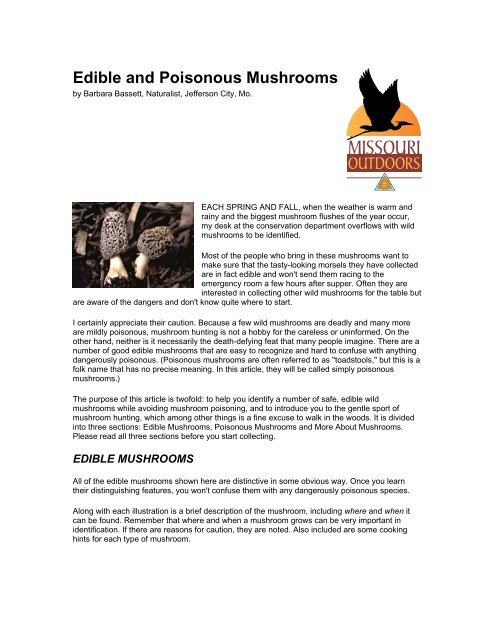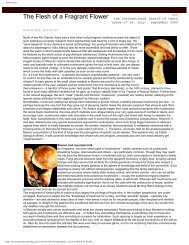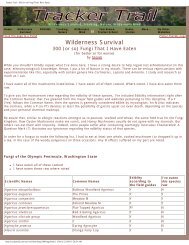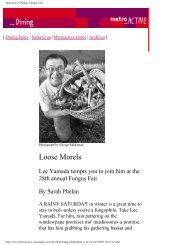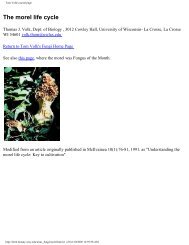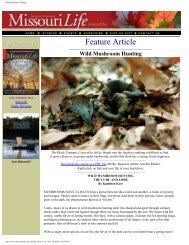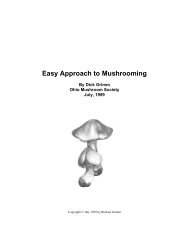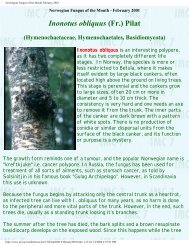Create successful ePaper yourself
Turn your PDF publications into a flip-book with our unique Google optimized e-Paper software.
PUFFBALLS (LYCOPERDON spp. <strong>and</strong>CALVATIA spp.)Description: Depending on their size, puffballs havebeen mistaken at a distance for everything from golfballs to sheep.These round or pear-shaped <strong>mushrooms</strong> are almostalways whitish, tan or gray <strong>and</strong> have no stalks. Theinterior of a puffball is solid white at first, gradually turning yellow, then brown as the mushroomages. Finally, the interior changes to a mass of dark, powdery spores, Size: 1" to 12" in diameter,sometimes larger.When <strong>and</strong> Where: Late summer <strong>and</strong> fall; in lawns, openwoods, pastures, barren areas. On soil or decaying wood.Cautions: Each puffball should be sliced from top to bottom<strong>and</strong> the interior examined. It should be completely white <strong>and</strong>featureless inside, like a slice of white bread. There should beno trace of yellow or brown (which will spoil the flavor) <strong>and</strong>especially no sign of a developing mushroom with a stalk,gills <strong>and</strong> cap (see page 9). Amanitas, when young, canresemble small puffballs, but cutting them open will quicklyresolve the question.Cooking Hints: Remove outer skinif it is tough, then slice, dip in batter <strong>and</strong> fry.SHAGGY MANE (Coprinus comatus)Description: The shaggy mane or lawyer's wig is so large <strong>and</strong> distinctivethat with a little practice you can identify it from a moving car.The cap of a fresh specimen is a long, white cylinder with shaggy, upturned,brownish scales. The gills are whitish, <strong>and</strong> the entire mushroom is fragile <strong>and</strong>crumbles easily. Most important, as the shaggy mane matures, the cap <strong>and</strong>gills gradually dissolve into a black, inky fluid, leaving only the st<strong>and</strong>ing stalk.Size 4" to 6" tall, sometimes larger.When <strong>and</strong> Where: Spring, summer <strong>and</strong> fall, growing ingrass, soil or wood chips. Often seen scattered in lawns <strong>and</strong>pastures.Cautions: Shaggy manes are best when picked before thecaps begin to turn black. However, until you become familiar with these<strong>mushrooms</strong>, check for the developing ink to be sure of your identification. (note:The shaggy mane is the largest of a group of <strong>edible</strong> <strong>mushrooms</strong> called inkycaps. The field guides listed at the end of this article can help you identify othermembers of this group.)Cooking Hints: Saute butter <strong>and</strong> season with nutmeg or garlic. Good in scrambled eggs orchicken dishes. Shaggy manes are delicate <strong>and</strong> should be picked young <strong>and</strong> eaten the sameday.
CORAL FUNGI (Clavariaceae)Description: These fungi appear as clumps of branching stemswhich point upward. They do look much like coral. Most are tan,whitish or yellowish; a few are pinkish or purple.Also called club fungi, antler <strong>mushrooms</strong> or doghair <strong>mushrooms</strong>.Size: clusters may be up to 8" high.When <strong>and</strong> Where: Summer <strong>and</strong> fall; in wooded areas, growingon the ground or on decaying logs.Cautions: A few coral fungi have a laxative effect, <strong>and</strong> somepeople seem to be particularly sensitive. Avoid coral fungi thattaste bitter, bruise brown when h<strong>and</strong>led or have gelatinousbases. These are most likely to case trouble. No seriouspoisonings from coral fungi have been reported.Cooking Hints: Tips <strong>and</strong> upper branches are most tender. Saute<strong>and</strong> add to vegetables or whitesauce.MORELS( Morchella spp.) Description: Sponge,pinecone <strong>and</strong> honeycomb mushroom-thenicknames of the morel-are allappropriate. Morels are easy to recognize<strong>and</strong> delicious to eat, making them themost popular wild mushroom in Missouri.The surface of a morel is covered withdefinite pits <strong>and</strong> ridges, <strong>and</strong> the bottomedge of the cap is attached directly to thestem. Size: 2" to 12" tall.There are three commonspecies of morels:(left) Common Morel (center) Half-Fre e Morel (right) Black Morel1. The common morel (Morchellaesculenta): When young, this species has white ridges <strong>and</strong> dark brown pits <strong>and</strong> is knownas the "white morel." As it ages, both the ridges <strong>and</strong> the pits turn yellowish brown, <strong>and</strong> itbecomes a "yellow morel." If conditions are right the "yellow morel" can grow into a "giantmorel," which may be up to a foot tall.2. The black morel or smoky morel (Morchella elata): The ridges are gray or tan whenyoung, but darken with age until nearly black. The pits are brown <strong>and</strong> elongated. Thesemorels are best when picked young; discard any that are shrunken or have completelyblack heads.
3. The half-free morel (Morchella semilibera): This is the exception to the rule that morelshave the bottom of the cap attached directly to the stem. The cap of the half-free morel isattached at about the middle (see illustration). These morels have small caps <strong>and</strong> longbulbous stems.When <strong>and</strong> Where: From spring to earlysummer. Morels are found on the ground in avariety of habitats, including moist woodl<strong>and</strong>s<strong>and</strong> in river bottoms.Cautions: Morels are quite distinctive, butthere is a small chance they could beconfused with false morels. See page 10forways to distinguish true morels fromfalse morels.Half-free morels may be confused with a mushroom called the wrinkled thimble cap (Verpabohemica). Fortunately, this mushroom is also <strong>edible</strong> in moderation. The cap of the wrinkledthimble cap is free from the stem except at the top (see illustration).Cooking Hints: Cut morels in half to check for insects. Wash carefully. Morels can be breaded<strong>and</strong> fried, stewed, baked, creamed or stuffed with dressing. Their delicate flavor is brought outbest by sauteing them in butter for about five minutes on each side.Bearded Tooth - (Hericium erinaceus)Description: With its clumps of hanging white "fur," thistooth fungus looks much like a polar bear's paw. It ispure white when fresh <strong>and</strong> young, but yellows with age.The bearded tooth may grow quite large, as much as afoot across. Its size <strong>and</strong> whiteness make it easy to spotagainst the dark logs on which it grows.Other names include bear's head, satyr's beard <strong>and</strong> hedgehog mushroom. Size 4" to 12" across.When <strong>and</strong> Where: Summer <strong>and</strong> fall; always on trees, logs or stumps.Cautions: The bearded tooth is distinctive <strong>and</strong> has no <strong>poisonous</strong> look-alikes. There are severalclosely related species which are more open <strong>and</strong> branched, but all are good <strong>edible</strong>s.Only young, white specimens should be eaten; older, yellowed ones are sour.Cooking Hints: Slice, parboil until tender (taste a piece to test), drain <strong>and</strong> serve with cheesesauce.
Oyster Mushroom (Pleurotus ostreatus)Description: Those hardy souls who take long winter walks aresometimes treated to the sight of a snow-capped mass of freshoyster <strong>mushrooms</strong> growing on a tree or log.This large white, tan or ivory-colored mushroom is named for itsoyster shell-like shape. It has white gills running down a veryshort, off-center stem. Spores are white to lilac, <strong>and</strong> the flesh isvery soft. Oyster <strong>mushrooms</strong> usually are found in large clustersof overlapping caps <strong>and</strong> always on wood. Size: 2" to 8" wide.When <strong>and</strong> Where: Spring, summer, fall <strong>and</strong> during warm spellsin winter. On trees <strong>and</strong> fallen logs.Cautions: This mushroom has a number of look-alikes,(including Crepidotus <strong>and</strong> Lentinus spp.), but none aredangerous. they may, however, be woody or unpleasanttasting.Check by tasting a small piece <strong>and</strong> by making a sporeprint (see page 12). Watch out for the small black beetles whichsometimes infest this mushroom.Cooking Hints: Soak in salted water to remove bugs. Dip in beaten egg, roll in cracker crumbs<strong>and</strong> fry.Chanterelles (Cantharellaceae)Description: Chanterelles are a great favorite ofEuropean mushroom hunters <strong>and</strong> are becoming morepopular in the United States.These <strong>mushrooms</strong> are funnel-or trumpet-shaped <strong>and</strong>have wavy cap edges. Most are bright orange or yellow,although one, the black trumpet, is brownish-black.Fresh chanterelles have a pleasant, fruity fragrance.To make sure you have a chanterelle, check theunderside of the cap. Some species of chanterelle arenearly smooth underneath, while others have a networkof wrinkles or gill-like ridges running down the stem.The ridges have many forks <strong>and</strong> crossveins <strong>and</strong> arealways blunt-edged. (True gills are sharp-edged <strong>and</strong>knifelike). Size 1/2" to 6" wide, 1" to 6" tall.When <strong>and</strong> Where: Summer <strong>and</strong> fall; on the ground inhardwood forests. Usually found in scattered groups.(top) Chanterelles (bottom) Black TrumpetCautions: When you can recognize those blunt-edged,crisscrossing ridges, you won't confuse chanterelles with anything else. However, take extra careat first that you do not have the <strong>poisonous</strong> jack-o-'lantern (see page 11). Jack-o'-lanterns haveknifelike gills <strong>and</strong> grow in the tight clusters on wood or buriedwood, rather than on the ground.
Cooking Hints: Chanterelles are tough <strong>and</strong> need long, slow cooking, but when properly preparedtheir flavor is excellent. Saute slowly in butter until tender, season with salt, pepper <strong>and</strong> parsley,<strong>and</strong> serve on crackers.Boletes (Boletaceae)Description: If you can picture a hamburger bun on athick stalk, you will have a good idea of what mostboletes look like. These sturdy, fleshy <strong>mushrooms</strong> canbe mistaken at first glance for gilled <strong>mushrooms</strong>, but ifyou turn over a cap you will find a spongy layer of poreson the underside rather than bladelikegills. The porelayer can easily be pulled away from the cap.Bolete caps are usually brownish or reddish-brown,while the pores may be whitish, yellow, orange, red,olive or brownish. Size: Up to 10" tall; caps 1" to 10"wide.There are more than 200 species of boletes in NorthAmerica. The King Bolete (Boletus edulis) is probablythe best <strong>edible</strong>.When <strong>and</strong> Where: Summer <strong>and</strong> fall; on the groundnear or under trees. Frequently found under pines.Cautions: Boletes are considered a good, safe <strong>edible</strong>group for beginning mushroom collectors. However,you should observe these cautions:1. A few boletes are <strong>poisonous</strong>. To avoid these, don'teat any boletes that have orange or red pores.(left) Boletes (right) King Bolete2. Some boletes, while not <strong>poisonous</strong>, are very distasteful. Check this by tasting a pinch of theraw mushroom cap. If it is bitter or otherwise unpleasant, throw it out.3. To make them more digestible, boletes should be cooked before eating. If the cap is slimy,peel off the slime layer; it sometimes causes diarrhea.4. Bugs seem to like boletes as much as people do, so check your specimens carefully. Boletesalso tend to decay quickly. Be sure to collect <strong>and</strong> eat only fresh specimens.Cooking Hints: Remove tough stems, <strong>and</strong> peel off the pore layer in all but the youngestspecimens.Saute in butter <strong>and</strong> add to any cheese dish. Dried boletes also are good in soups.
Sulfur Shelf (Laetiporus sulphureus)Description: These <strong>mushrooms</strong> light up the forest withtheir brilliant orange-red caps <strong>and</strong> pale sulfur-yellow poresurfaces. Some specimens fade to a peach or salmoncolor.The sulfur shelf always grows on wood, usually in largemasses of overlapping caps. It has no stem; the cap isattached directly to the wood. The pores are tiny.Other names include chicken mushroom <strong>and</strong> chicken ofwoods. Size 2" to 12" wide.When <strong>and</strong> Where: Summer <strong>and</strong> fall; in clusters on living trees or dead wood.Cautions: This is a distinctive mushroom with no <strong>poisonous</strong> look-alikes. It does cause a mildallergic reaction (swollen lips) in some people.Cooking Hints: Cook only the tender outer edges of the caps; the rest is tough <strong>and</strong> woody. Slice<strong>and</strong> simmer in stock for 45 minutes, then serve creamed on toast.When cooked, this mushroom has the texture <strong>and</strong> often the taste of chicken.theHen-of-the-Woods (Grifolafrondosa)Description: This mushroom really does looksomething like a large, ruffled chicken. It growsas a bouquet of grayish-brown, fan-shaped,overlapping caps, with offcenter white talksbranching from a single thick base. On theunderside, the pore surface is white.A single clump of hen-of-the-woods can grow toenormous size <strong>and</strong> weigh up to 100 pounds. Itoften grows in the same spot year after year.When <strong>and</strong> Where: Summer <strong>and</strong> fall; on the ground at the base of trees, or on stumps.Cautions: Many gilled <strong>mushrooms</strong> grow in large clumps-remember that hen-of-the-woods is apore fungus.This mushroom has no <strong>poisonous</strong> look-alikes, but there are some similar species of pore fungithat are tough <strong>and</strong> in<strong>edible</strong>. If what you have tastes leathery or otherwise unpleasant, youprobably didn't pick a hen-of-the-woods.Cooking Hints: Use only fresh, tender portions. Simmer in salted water until tender (requireslong, slow cooking), <strong>and</strong> serve as a vegetable withcream sauce; or chill after cooking <strong>and</strong> use onsalads.
There are many other good <strong>edible</strong> wild <strong>mushrooms</strong> available to Missouri mushroom hunters,including the popular meadow <strong>mushrooms</strong>. If you'd like to try collecting some of these, thereferences listed at the end of this article will help you do so safely.POISONOUS MUSHROOMSEvery mushroom hunter should be familiar with the three most dangerous groups of fungi. Theseare the amanitas, the false morels <strong>and</strong> a catch-all category known as little brown <strong>mushrooms</strong>(LBMS). Mushrooms in these groups cause virtually all the fatal mushroom poisonings in theUnited States, with amanitas alone accounting for 90 percent of mushroom-related deaths. Thepictures <strong>and</strong> descriptions on the following pages will help you avoid them.There also are hundreds of other <strong>mushrooms</strong> that will cause anything from a mild stomachacheto severe physical distress-including vomiting, diarrhea, cramps <strong>and</strong> loss of coordination. Twocommon <strong>poisonous</strong> <strong>mushrooms</strong> of this type, the jack-o'lantern <strong>and</strong> the green-spored Lepiota, aredescribed here. Although the symptoms of poisoning from these <strong>mushrooms</strong> may be alarming,they usually pass in 24 hours or less with no lasting effects. You should, however, notify yourdoctor immediately if you suspect mushroom poisoning of any kind.There is no quick <strong>and</strong> easy test that will separate <strong>edible</strong> from <strong>poisonous</strong> <strong>mushrooms</strong>-includingpeeling the cap, testing with a silver spoon, checking for insect damage or any other folk method.To avoid mushroom poisoning, you should follow these five rules:1. Identify each <strong>and</strong> every mushroom you collect, <strong>and</strong> only eat those whose identificationyou are sure of. When in doubt, throw it out.2. Strictly avoid: any mushroom that looks like an amanita (parasol-shaped <strong>mushrooms</strong> withwhite gills); all little brown <strong>mushrooms</strong>; all false morels.3. Some people are allergic to even the safest <strong>mushrooms</strong>. The first time you try a new wildmushroom, it is important that you eat only a small amount <strong>and</strong> wait 24 hours beforeeating more.4. 4As with other foods, rotting <strong>mushrooms</strong> can make you ill. Eat only firm, fresh,undecayed <strong>mushrooms</strong>.5. Most wild <strong>mushrooms</strong> should not be eaten raw or in large quantities, since they aredifficult to digest.
Amanitas (Amanita spp.)Amanitas are the reason why there are no old, boldmushroom hunters. Several members of this groupcontain amanitin, one of the deadliest poisons found innature. One cap of a Destroying Angel (Amanita virosa)can kill a manAn amanita starts as an egg-shaped button which canresemble a small puffball. This breaks open as themushroom grows. Fully developed amanitas are gilled<strong>mushrooms</strong> with parasol-shaped caps that may be white,yellow, red or brown. They also have the followingcharacteristics:1. A saclike cup surrounding the base of the stem. This often is buried just beneath the soilsurface <strong>and</strong> may not be obvious.2. A ring on the stem.3. White gills.4. A white spore print (see page 12).Both the ring <strong>and</strong> the bulb may be destroyed by rain or other disturbance. For this reason,beginning mushroom hunters should avoid all parasol-shaped <strong>mushrooms</strong> with white gills.Amanitas are usually found on the ground in woodl<strong>and</strong>s in summer <strong>and</strong> fall, but be on the lookoutfor them whenever you hunt for <strong>mushrooms</strong>.False Morels (Helvella <strong>and</strong> Gyromitra spp.)False morels are difficult to treat in an article on <strong>edible</strong><strong>and</strong> <strong>poisonous</strong> <strong>mushrooms</strong>, because they so clearly fitboth categories.On one h<strong>and</strong>, many people have enjoyed eating falsemorels for years <strong>and</strong> may even consider them a favoritewild mushroom. On the other, false morels havedefinitely caused serious illnesses <strong>and</strong> deaths in theUnited States.The problem seems to involve the amount of a toxicchemical, called monomethyl hydrazine (MMH), presentin these <strong>mushrooms</strong>. MMH causes diarrhea, vomiting<strong>and</strong> severe headaches, <strong>and</strong> occasionally it can be fatal.However,because of different cooking techniques <strong>and</strong>different individual sensitivities to MMH, false morelsHelvella sp. Gyromitra carolinianapoison some people but leave others unaffected. Inaddition, false morels in some areas of the countrycontain more MMH than in other areas. All this makes these <strong>mushrooms</strong> a very doubtful group asfar as edibility is concerned.False morels have wrinkled, irregular caps that are brainlike or saddle-shaped. They may beblack, gray, white, brown or reddish. (The "big red morel," Gyromitra caroliniana, common in
Missouri, is a large false morel with a reddish cap.) Other names include elephant ears, Arkansasmorels <strong>and</strong> brian <strong>mushrooms</strong>. Size 2" to 8" tall.False morels differ from true morels in two obvious ways:1. The cap surface has lobes, folds, flaps or wrinkles, but it does not have pits <strong>and</strong> ridgeslike a true morel. You might say their caps bulge outward instead of being pitted inward.2. The bottom edge of the cap of a false morel hangs free around the stem, like a skirt. Ontrue morels, the bottom edge of the cap is attached to the stem (see page 4).False morels are found in spring, summer <strong>and</strong> fall, on the ground in woodl<strong>and</strong>s.Note: Because these <strong>mushrooms</strong> have definitely caused deaths, we cannot recommend that youeat them. If you nevertheless choose to do so, they should be thoroughly cooked in a wellventilatedroom, since MMH is driven off by heat.Little Brown Mushrooms (LBMs)Like the LGBs (little gray birds) of the birdwatchers, this is acatchall category. It includes all small to medium-sized, hard-to-identify brownish mushroom with spores of all colors-ofwhich there are many hundreds.Many LBMs are harmless, some are mildly <strong>poisonous</strong> orhallucinogenic, <strong>and</strong> a few are deadly. The innocent-looking little<strong>mushrooms</strong> of the genus Galerina are probably the most dangerous ofthe LBMs. They contain the same toxin as amanitas <strong>and</strong> have causeda number of deaths. Galerinas grow in clusters on wood <strong>and</strong> havebrownish spores.Because they are so difficult to identify, all LBMs should be avoided.Little brown <strong>mushrooms</strong> are found in spring, summer <strong>and</strong> fall, in all habitats. Poisonous LBMSmay grow on soil or wood <strong>and</strong> may appear in lawns, pastures or forests.Jack-O'-Lantern (Omphalotus olearius)The bright-orange is well named. Not only is it pumpkin-colored <strong>and</strong>found in the fall- it also glows in the dark. Fresh specimenssometimes give off a faint greenish glow at night or in a darkenedroom.
These common <strong>mushrooms</strong> have caused many poisonings because they look, smell <strong>and</strong> eventaste good. They cause mild to severe stomach upset but arenot life-threatening to healthyadults.Jack-O'-lanterns have a pleasant, fruity fragrance. They are sometimes mistaken for the <strong>edible</strong>chanterelle (see page 6), which is the same color <strong>and</strong> also has pleasant smell. Chanterelles,however, have flat-edged, interconnecting ridges or wrinkles instead of knifelike gills, <strong>and</strong> grow onthe ground. Size 3" to 10" tall, cap 3" to 8" diameter.These <strong>mushrooms</strong> are found in summer <strong>and</strong> fall, in large clusters at the base of trees, on stumpsor on buried wood.The jack-o'-lantern <strong>and</strong> green-spored lepiota are only two of a large number of <strong>mushrooms</strong> thatcan cause mild to severe (though not life-threatening) illness if eaten. To avoid poisoning fromthese <strong>mushrooms</strong>, be sure to follow the rules on page 8.Green-spored Lepiota (Chlorophyllum molybdites)These large, common <strong>mushrooms</strong> often appear in fairy rings onsuburban lawns, <strong>and</strong> are frequently eaten by the lawn's owner-to his orher regret. They cause violent gastrointestinal upset.The green-spored lepiota is parasol-shaped <strong>and</strong> has a cream or tan,scaly cap, a large ring on the stem <strong>and</strong> cream-colored gills which turndingy green with age. As its name suggests, it is the only mushroomwith a greenish spore print. Size 4" to 12" tall, 2" to 12" in diameter.This mushroom is found in summer <strong>and</strong> fall, on the ground in lawns, pastures <strong>and</strong> meadows.MORE ABOUT MUSHROOMSWhat is a mushroom? Mushrooms are actually the fruits of fungus. The fungus itself is simply anet of threadlike fibers, called a mycelium, growing in soil, wood or decaying matter. Mushroomson a mycelium are like apples on an apple tree.The function of a mushroom is to produce spores, which are the "seeds" of the fungus. Somekinds of <strong>mushrooms</strong> produce their spores on gills (the gilled fungi);some in pores (the pore fungi);some on teeth (the tooth fungi); some inside a leathery pouch (thepuffballs); some on the insideof shallow cups ( the cup fungi, including the morels); <strong>and</strong> some simply on the surface of themushroom (coral fungi <strong>and</strong> others). The spores form on these various structures, then fall off toblow away on the wind or be carried by animals, water or insects. If a spore l<strong>and</strong>s in a suitablespot, it germinates <strong>and</strong> grows into a new mycelium.The <strong>mushrooms</strong> most people recognize are the gilled fungi. These typical parasol-shaped<strong>mushrooms</strong> have caps with bladelike gills on the underside <strong>and</strong> stems with or without rings. Thepore fungi are similar in appearance but have a spongy layer of tubes of pores on the undersideof the cap instead of gills.
Collecting <strong>mushrooms</strong>Mushroom collecting requires only the simplest of equipment: a flat-bottomed basket or box, a rollof waxed paper, a digging tool <strong>and</strong> a pencil <strong>and</strong> paper for notes.Be sure to collect the entire mushroom, including the base. Take only fresh, young specimensthat are free of insect damage. Each type of mushroom should be wrapped separately in waxedpaper (not plastic wrap, which hastens decay), along with any notes you might want to makeabout the habitat <strong>and</strong> appearance of the mushroom. It's a good idea to note where the mushroomis growing (on wood, soil, moss); whether it is single or in clusters' the colors of the caps, gills <strong>and</strong>stem; <strong>and</strong> any other distinctive features. The more you can observe about the mushroom in thefield, the easier it will be to identify at home.Making a spore printIndividual spores are too small to be seen with the naked eye, but you can make a spore printthat will show the color of the spores in mass. This color is an important identifying characteristicfor many <strong>mushrooms</strong>, especially the gilled fungi.To make a spore print, cut the stem off the mushroom <strong>and</strong> place the cap gill-side or pore-sidedown on a piece of white paper. To best see the spore color, use on sheet of black paper <strong>and</strong>one of white, taped together side-by-side. Cover with a bowl or jar. If the mushroom is at the rightstage-not too young, too old or deteriorated-the spores will slowly collect on the paper. A sporeprint will be visible in one to 12 hours.Other Books About Mushrooms*• The Audubon Society Field Guide to North American Mushrooms by Gary H Lincoff. Alfred A Knopf, 1981.• Mushrooms of North America by Orson K Miller, Jr. E. P. Dutton, 1977 (paperback edition).• The Mushroom Trail Guide by Phyllis G Glik. Holt, Rinehart <strong>and</strong> Winston, 1979.• The Mushroom Hunters Field Guide by Alex<strong>and</strong>er H Smith <strong>and</strong> Nancy Smith Weber. University of MichiganPress, 1980.*Available by order at bookstores.Copyright 1983 by the Conservation Commission of the State of Missouri reprinted fromthe Missouri Conservationist


